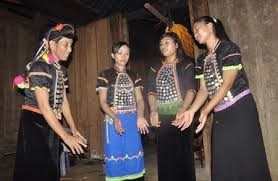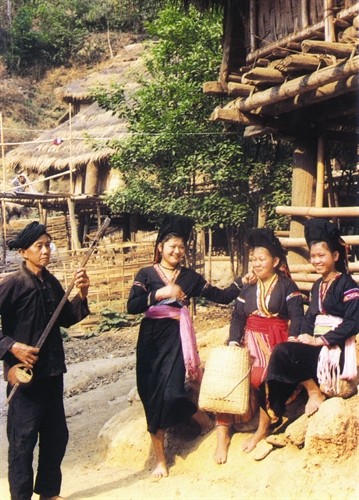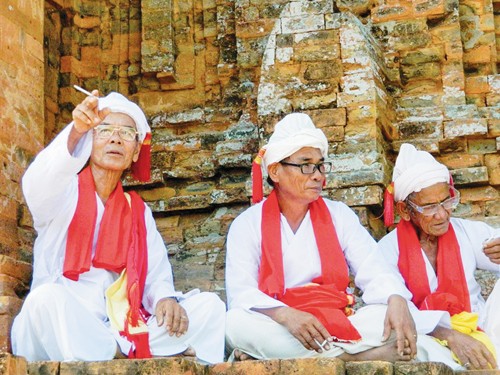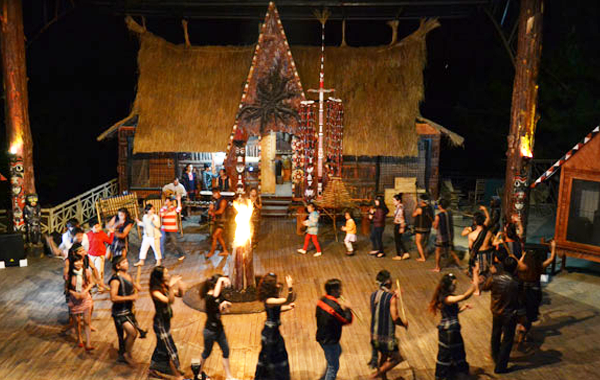The Si La ethnic people, with a population of just over 700, live mainly in Lai Chau province. At a funeral, Si La people do not cry or lament, but instead organize recreational activities like dancing, singing and playing games.
 Si La ethnic minority people live mainly in Lai Chau northwestern province (Photo: Lai Chau Newspaper) Si La ethnic minority people live mainly in Lai Chau northwestern province (Photo: Lai Chau Newspaper) |
Ms. Hù Cố Xuân of Seo Hai hamlet, Muong Te district, told VOV: “There are two activities that are commonly done at a funeral of the Si La people. People dance around the coffin and play ritual dance music on bamboo instruments.”
The Si La people think it’s important to wash the dead body. Before putting the deceased person into a coffin, people wash the body with “a hé” grass to cleanse it of evil. Then the people begin to dance.
“We dance to deliver the deceased safely to the world of our ancestors. Anyone can dance, males, females, sons, daughters, even the grandchildren. They dance and sing a song urging to the deceased to “rest in peace, now that you have passed away, and bless the living with good health.” Dance moves for males and females are quite distinct from each other. A man dances as if he is swimming, and a woman will simply move her hands up and down,” said Ms Xuan
According to Ms. Hu Co Xuan, dancing brings joy to the deceased. The more people dance, the happier the deceased will be: "The dance makes the deceased’s soul happy as it enters the afterlife. If someone in your family passes away and nobody dances, people will assume the deceased had no friends or anyone who cared about them. The more people dance, the more peaceful the deceased’s soul will be.”
In addition to dancing and singing, Si La people express their joy at funerals by playing games. Xuan told VOV: “We can laugh very comfortably. If we cry or are sad, the deceased will not feel relief. Games are played after dinner, when people have finished burying the deceased. Traditionally, drums and gongs are played, but these days that’s rarely done.”
Si La people bury dead family members in a cemetery near their hamlet. Graves of people with the same surname are placed close to each other. After people choose a nice piece of land in which to bury the coffin, they dig a small hole and put a piece of coal in it to mark the spot. The coffin, made from hollowed-out wood, is buried there the following morning. After the burial, the mourning family uses water to to extinguish the fire.
 Cong ethnic minority live mainly in Vietnam's northwestern region (Photo: dantocmiennui.vn) Cong ethnic minority live mainly in Vietnam's northwestern region (Photo: dantocmiennui.vn) |
The Cong ethnic people who live mainly in Vietnam's northwestern region wear new clothes at the funeral of a family member. Like other ethnic groups, when a Cong person dies, the whole village helps organize the funeral. The deceased is placed in a hollowed-out wooden coffin, but they is not nailed shut. Cong people believe that if the coffin is nailed, the deceased’s soul will not be able to get to heaven, but will remain trapped on the earth and haunt the living.
When someone dies, their family changes the stairs in their house. The living and the dead can not use the same stairs. Changing the stairs is known as “opening another way for the ghost”.
At a Cong funeral, people do not cry or express sorrow. They put on nice, new clothes for the benefit of the deceased person. Cong people believe that when they die, they will meet their ancestors, and they must dress nicely. If they wear worn, shabby clothes, their soul can’t join the ancestors’ world. Late Meritorious Teacher Hoang Luong once told VOV: “Cong people have to prepare their burial clothes while they are still living, at the age of 50 or 60. They believe passing away means meeting the ancestors, which is a happy event, so there is no reason to cry or mourn, and one must wear new clothes.”
The Cong never hold a funeral on “mẹo" day, the day of the monkey, for fear that the deceased will rise and turn into a monkey, or on “khà" day, the day of the tiger, for fear that the deceased will turn into a tiger and harm the villagers. Cong people don’t perform funerals on the first, second, or last day of a month, or on the birthday of the deceased, for fear that the deceased will be reborn. After bidding farewell to the deceased at their grave, Cong people return to their houses, lock their doors, and pray that the deceased doesn’t take their soul with him or her. Mr Luong said: “Cong beliefs are influenced by animism. The Cong think a man’s soul has many parts, which can transform into evil animals if the body is buried on certain days. The Cong people worship many gods.”
 Cham high-rank officials in their ceremonial clothes (Photo: baotintuc.vn) Cham high-rank officials in their ceremonial clothes (Photo: baotintuc.vn) |
The Cham Ba La Mon ethnic minority of south central Vietnam practice cremation. A Cham Ba La Mon, or Ba Cham funeral, lasts for 4 days and recapitulates the process of human birth. The first day of a person’s life until his last day represents the pregnancy, and the day of cremation represents the day of birth. Ba Cham people believe that from the first day of the funeral the deceased is no longer dead. Doctor Trương Văn Món, an expert on Cham culture said: “Ba Cham people consider the funeral tent a symbol of a woman in the process of giving birth. The dead body is the newborn child. On the second pillar of the cemetery house, there is a wooden penis and a big hole, symbolizing a vagina. These represent fertility. The death of a person serves the prosperity of his or her offspring and is the beginning of a new life.”
Considering the dead body a baby waiting to be born, Ba Cham people “feed the baby.” The feeding ritual symbolizes giving a baby water, salt, and rice. Dr. Le Duy Dai of the Vietnam Ethnology Association says that in the ritual, Ba Cham people clap their hands to pray for a fulfilling afterlife: “They always clap their hands according to the rule “twice for, once against”. A “for clap” is done the right hand on top of the left. An “against clap” is the reverse. The same rule applies to the feeding ritual. Counter-clockwise is “for”, clockwise is “against”. The “twice for, once against” ratio represents 2 yins and 1 yang.”
 K'Ho people dance in a traditional festival K'Ho people dance in a traditional festival |
A funeral of the K’ho ethnic people, who live mainly in Vietnam’s Central Highlands also lasts 4 days, but includes different rituals. When someone passes away, the family beats a drum to inform the neighbors. Close relatives bring food and drink and helps organize the ceremony. Mr. Ka Bro of K’Minh village in Lam Dong province said: “People bring a kilogram of rice, or a bottle of rượu cần, a fermented rice liquor, or just money. If a person is not wealthy, they will usually bring some food to the funeral.”
A traditional K’Ho funeral lasts 4 days. The first day is for informing the neighbors. On the 2nd and 3rd day, the family prepares the coffin and offerings for the ceremony. K’Ho people never make the coffin in advance. Once someone passes away, the family goes to the forest, cuts down a tree, makes a coffin, and decorates it with carvings of familiar animals. Mr. Ka Bro told VOV: “The body is placed in the coffin on the 2nd day of the funeral. If the deceased is a man, his wife’s family prepare the feast for the 2nd day. The next day, it’s the turn of the deceased’s family. They dig the grave and bury the coffin on the 4th day.”
Before putting the body in the coffin, K’Ho people perform a ritual offering which bestows on the deceased objects they used to have when they were alive.
“They use a small pot to hold clothes and other belongings of the deceased. If the deceased acquired a fortune during their life, they are buried with an offering of gold,” said Ka Bro.